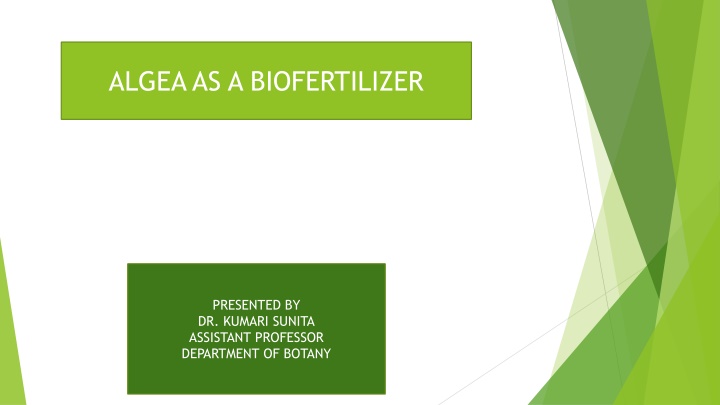
Utilizing Algae as Biofertilizer for Sustainable Agriculture Practices
Utilizing algae as biofertilizer in agriculture offers numerous benefits such as soil aggregation, nutrient restoration, and improved crop growth. Blue green algae, or cyanobacteria, have proven to be effective in nitrogen fixation and enhancing soil properties. This innovative approach is cost-effective and environmentally friendly, providing a feasible solution for sustainable agricultural development.
Download Presentation

Please find below an Image/Link to download the presentation.
The content on the website is provided AS IS for your information and personal use only. It may not be sold, licensed, or shared on other websites without obtaining consent from the author. If you encounter any issues during the download, it is possible that the publisher has removed the file from their server.
You are allowed to download the files provided on this website for personal or commercial use, subject to the condition that they are used lawfully. All files are the property of their respective owners.
The content on the website is provided AS IS for your information and personal use only. It may not be sold, licensed, or shared on other websites without obtaining consent from the author.
E N D
Presentation Transcript
ALGEA AS A BIOFERTILIZER PRESENTED BY DR. KUMARI SUNITA ASSISTANT PROFESSOR DEPARTMENT OF BOTANY
Sustainable agriculture is advantageous over conventional agriculture for its capacity to accomplish food demand by utilizing environmental resources without negatively affecting it The simple presence of BGA in soil results in formation of soil aggregates, which reduces soil loss during rainy season and regulates aeration, soil temperature, hence, improving physical and chemical properties of soil vis- a-vis physical environment of the crop. BGA are helpful in restoring soil nutrients by secreting exopolysaccharides and bioactive substances. They have the potential to mobilize insoluble forms of inorganic phosphates. Algalization has been employed for reducing the amount of exchangeable sodium, which results in altered soil pH and leads to reclamation of sodic soils. Some red algae used as biofertilizers have been found to augment growth nutritional value and yield of crop plants.
Blue green algae are referred to as rice organisms because of their abundance in the rice field. Many species belonging to the genera, Tolypothrix, Nostic, Schizothrix, Calothrix, Anoboenosois and Plectonema are abundant in tropical conditions. Most of the nitrogen fixation BGA are filamenters, consisting of chain of vegetative cell including specialized cells called heterocyst which function as a micronodule for synthesis and N fixing machinery.
A theoretical representation exhibits the potential functions of cyanobacteria in sustainable agriculture and the environment
Cyanobacteria are emerging microorganism for sustainable agri-cultural development. Diazotrophes are cyano-bacteria useful for the generation of eco-friendly biofertilizers whichare easily available and less costly. They can control the nitrogen de-ficiency in plants, improve the aeration of soil, water holding capacityand add vitamin. The most efficient nitrogen-fixing cya-nobacteria are Nostoc linkia, Anabaena variabilis, Aulosira fertilisima,Calothrix sp., Tolypothrix sp., and Scytonema sp. are present in the ricecrop cultivation area.
Benifits Use of BGA is more economical than fertilizers Reduce cultivation cost (approx. 1000/per acre) Organic farming high value output More biomass and soil moisture for next crop More fodder avilability
